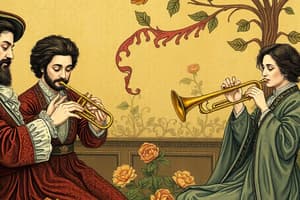Podcast
Questions and Answers
What marked the end of the baroque period in music?
What marked the end of the baroque period in music?
- George Frideric Handel's death
- The appearance of long-playing records
- The baroque revival in the late 1940s
- Johann Sebastian Bach's death (correct)
What type of texture did early baroque composers favor?
What type of texture did early baroque composers favor?
- Homophonic (correct)
- Monophonic
- Heterophonic
- Polyphonic
Who were the two giants of baroque composition?
Who were the two giants of baroque composition?
- Johann Sebastian Bach and Claudio Monteverdi
- Arcangelo Corelli and Antonio Vivaldi
- George Frideric Handel and Johann Sebastian Bach (correct)
- Claudio Monteverdi and Henry Purcell
What spurred the 'baroque revival' in the late 1940s?
What spurred the 'baroque revival' in the late 1940s?
During the early baroque period, what type of texture was emphasized by composers?
During the early baroque period, what type of texture was emphasized by composers?
What characterized the musical style during the middle phase of the baroque period?
What characterized the musical style during the middle phase of the baroque period?
What marked the late baroque period in terms of instrumental music?
What marked the late baroque period in terms of instrumental music?
What was a notable feature of the middle baroque phase in terms of scales?
What was a notable feature of the middle baroque phase in terms of scales?
What characterized the early baroque composers' use of dissonance?
What characterized the early baroque composers' use of dissonance?
What was the tonal basis of most compositions by about 1690?
What was the tonal basis of most compositions by about 1690?
What was a notable feature of the late baroque period in terms of harmony?
What was a notable feature of the late baroque period in terms of harmony?
What characterized the use of instruments in early baroque music?
What characterized the use of instruments in early baroque music?
Flashcards are hidden until you start studying
Study Notes
End of the Baroque Period
- The end of the Baroque period in music is marked by the emergence of new styles and composers, such as Haydn and Mozart, who paved the way for the Classical period.
Early Baroque Composers
- Early Baroque composers favored a complex, intricate texture, often featuring multiple independent melodic lines.
Giants of Baroque Composition
- The two giants of Baroque composition are Bach and Handel, renowned for their contributions to the period's musical landscape.
Baroque Revival
- The 'Baroque revival' in the late 1940s was spurred by the rediscovery of original Baroque instruments and performance practices.
Early Baroque Period
- During the early Baroque period, composers emphasized a complex, contrapuntal texture, characterized by interweaving melodic lines.
Middle Baroque Period
- The middle phase of the Baroque period was characterized by a more expressive, ornate, and decorative musical style.
Late Baroque Period
- The late Baroque period was marked by the development of instrumental music, particularly the concerto grosso and solo concerto.
Middle Baroque Phase
- A notable feature of the middle Baroque phase is the widespread use of modal interchange, which involved borrowing notes from parallel modes.
Dissonance in Early Baroque Music
- Early Baroque composers used dissonance in a highly expressive and dramatic way, often leaving dissonances unresolved for longer periods than before.
Tonal Basis of Compositions
- By around 1690, the tonal basis of most compositions was functional tonality, with a central key and a sense of harmonic progression.
Late Baroque Harmony
- A notable feature of the late Baroque period is the increased use of chromaticism and a more complex approach to harmony.
Instrumental Music in Early Baroque
- In early Baroque music, instruments were often used in a vocal style, with intricate, ornamented lines that mimicked vocal music.
Studying That Suits You
Use AI to generate personalized quizzes and flashcards to suit your learning preferences.




